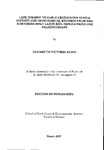Late Jurassic to Early Cretaceous stable isotope and geochemical records from the northern high latitudes: implications for palaeoclimate
| dc.contributor.author | NUNN, ELIZABETH VICTORIA | |
| dc.contributor.other | School of Geography, Earth and Environmental Sciences | en_US |
| dc.date.accessioned | 2013-09-16T12:18:29Z | |
| dc.date.available | 2013-09-16T12:18:29Z | |
| dc.date.issued | 2007 | |
| dc.identifier | NOT AVAILABLE | en_US |
| dc.identifier.uri | http://hdl.handle.net/10026.1/1760 | |
| dc.description | Merged with duplicate record 10026.1/861 on 07.03.2017 by CS (TIS) | |
| dc.description.abstract |
The Jurassic and Cretaceous periods are widely accepted as being dominated by greenhouse conditions with elevated CO2 levels and warm polar regions. Although much compelling evidence to support this idea of global warmth exists, some recent studies propose that the greenhouse climate may at times have been punctuated by sub-freezing polar conditions and the presence of limited polar ice. The evidence, however, is somewhat equivocal and is both spatially and temporally limited with much of this research until now being concentrated in mid- to low latitudes, despite it being generally accepted that global climate is defined to a significant degree by prevailing conditions at the poles. Existing data are also often plagued by poor sampling resolutions and dubious diagenetic histories. This research presents the first extensive stable isotope and geochemical investigation of well-preserved belemnite rostra from the Callovian-Hauterivian Boreal Realm. Belemnites of the genera Cylindroteuthis, Pachyteuthis, Acroteuthis, Lagonibelus and occasionally Belemnopsis were investigated. Preservation was assessed using Backscattered Scanning Electron Microscopy, Cathodoluminescence, carbonate staining and trace element techniques. Organic carbon isotope analysis of fossilised wood was also undertaken where possible. Material from Staffin Bay, Isle of Skye, and Helmsdale, Sutherland, Scotland; the Izhma River, Timan-Pechora Basin, Russia; the Boyarka River, Yenisei-IChatanga Basin, Siberia; and Festningen and Janusfjellet, Svalbard was analysed. The carbon isotope data record relatively positive values in the Oxfordian, followed by a gradual shift towards more negative values through the Kimmeridgian and into the Volgian/Tithonian. A distinct Late Valanginian positive carbon isotope excursion is identified in both the marine carbonate and terrestrial organic carbon records from the Izhma and Boyarka rivers. The excursion occurs at a time of relatively low sea level in Russia and Siberia. The exposure and erosion of lowland areas and restricted ocean circulation (and therefore enhanced stratification) associated with a period of sea-level lowstand may account for increased rates of organic carbon burial. The Late Valanginian positive carbon isotope excursion is coeval with a distinct cooling in the Russian Izhma River succession. This could be explained by a fall in atmospheric CO2 concentration and a subsequent drop in temperature as the result of significant burial of sediments rich in organic carbon. Further evidence for cold conditions during the Valanginian interval comes from glendonites and dropstones, which were identified on Svalbard. High latitude warmth is most likely the norm for the Late Jurassic and Early Cretaceous interval, although this warmth is likely to have been punctuated by cold conditions providing the opportunity for the development of at least a seasonal cover of polar ice. The oxygen isotope data record the occurrence of cold episodes during the Lower Oxfordian Cordatum Zone, the mid-Ryazanian Kochi-Analogits zones and the Upper Valanginian Bidichotomus Zone. Palaeotemperatures as low as 2°C were calculated, providing strong evidence for the existence of cold polar conditions at theses times. Ultimately, climatic instability is probably the key characteristic of this greenhouse interval. | en_US |
| dc.language.iso | en | en_US |
| dc.publisher | University of Plymouth | en_US |
| dc.title | Late Jurassic to Early Cretaceous stable isotope and geochemical records from the northern high latitudes: implications for palaeoclimate | en_US |
| dc.type | Thesis | |
| plymouth.version | Full version | en_US |
| dc.identifier.doi | http://dx.doi.org/10.24382/3859 | |
| dc.identifier.doi | http://dx.doi.org/10.24382/3859 |
Files in this item
This item appears in the following Collection(s)
-
01 Research Theses Main Collection
Research Theses Main


